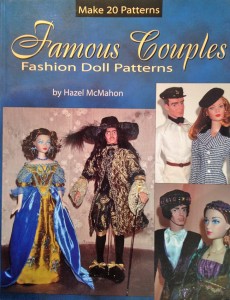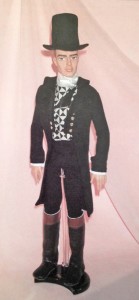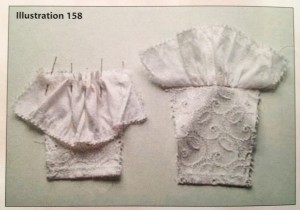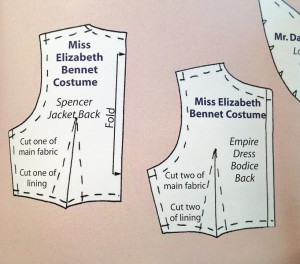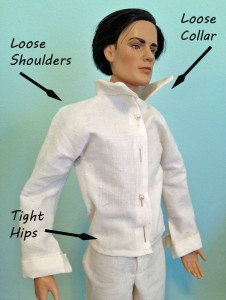Thursday’s Book Review: Famous Couples: Fashion Doll Patterns by Hazel McMahon
Rating
3 = Mediocre
Description
More than just a pattern book, Famous Couples provides step-by-step instructions to help you create historical costumes for your 16” fashion dolls. That includes Tyler Wentworth and Gene Marshall, as well as male fashion dolls like Trent Osborn and Matt O’Neill. You get ten patterns for the female doll and ten patterns for the corresponding male doll. The book is fully illustrated with color photographs.
Liked
I like the theme of the book—famous couples throughout history. Some are fictional, while others are historical figures. They are presented in chronological order, though not all major periods are represented.
- Classical (Ancient Egypt & Rome): Cleopatra & Marc Antony
- Renaissance (15th century): Romeo & Juliet
- Restoration (17th century): Charles II & Barbara Villiers
- French Directoire (late 18th century): Sir Percy Blakeney & Marguerite St. Just
- Regency (early 19th century): Mr. Darcy & Miss Elizabeth Bennet
- Early Victorian (mid 19th century): Queen Victoria & Prince Albert
- Late Edwardian (early 20th century): Titanic Era Couple
- 1920s: Rudolph Valentino & Vilma Banky
- 1930s: The Duke & Duchess of Windsor
- 1940s: Humphrey Bogart & Lauren Bacall
First, you learn a little about the characters. You’re given photos of the finished dolls, along with period illustrations to support the choice of silhouette, embellishment, and accessories. There is a recommended reading list, in case you’re interested in researching that period’s fashions in more detail. There’s also a supply list, so you know exactly how much fabric and trim you’ll need, followed by directions for assembling the patterns.
Accessories are included, such as hats, bonnets, shoes, and purses. Tips are given for trimming your costumes and for making jewelry and even wigs. All in all, it’s a very thorough book.
Disliked
I had four major complaints with the pattern book. First, the patterns are rather simplistic—using one-piece dolman sleeves instead of separate set-in sleeves, for example. And the men’s tailcoat is cut as one piece, without the curved back seams. Perhaps it’s easier for beginners to sew simplified garments, but I was hoping for something more historically accurate.
Second, I found it difficult to enlarge the patterns, as required, by 145%. The pages don’t open flat, which means you can’t just slip the book into the copier to enlarge the patterns. If you try, they’ll end up distorted. I ended up having to trace each pattern piece, then scan it and enlarge it digitally, then print the full-size pieces. It felt like a lot of wasted time when I was anxious to start sewing.
Third, I found the pattern directions lacking. Not only are the directions vague, and in some cases, missing altogether, but nowhere does the author mention what size the seam allowance is meant to be. That’s a serious omission. When you’re sewing doll clothing, the difference between 5/8″ and 1/4″ is pretty significant.
Fourth, the patterns themselves are hand drawn. Some of the lines are shaky or curved when, presumably, they ought to be straight. The author neglected to true the patterns, which is annoying. This can be done when you’re fitting the pattern to your doll, but it’s an extra step that shouldn’t be necessary. She also failed to mark the patterns. There are no notches to help you line the pieces up, and on some, there is no indication of center front and center back—which leads to considerable confusion when you’re trying to sew things together.
Conclusion
If you enjoy sewing for fashion dolls, but you’re frustrated at the lack of available patterns, you’ll find this book useful. It’s one of the few sources for male fashion doll patterns, which makes it a valuable commodity. However—and this is important—don’t trace the patterns and immediately cut them out of your good fabric! They are not an exact fit for every 16″ fashion doll and chances are high you’ll need to make some modifications. As with any project, always make a mockup first. It will save you time, money, and aggravation.
I had high hopes for this book, but it didn’t quite live up to my expectations. Even so, it’s worth having, even if you only use it as a jumping-off point for making your own patterns.
Buy It Now: Famous Couples: Fashion Doll Patterns
(Yesterday’s Thimble is a participant in the Amazon Services LLC Associates Program. Basically, this means if you click a link to an item that Amazon sells, and then buy it, I earn a small fee that helps support this website.)
~~*~~
Have you used this book? What did you think of its patterns?

